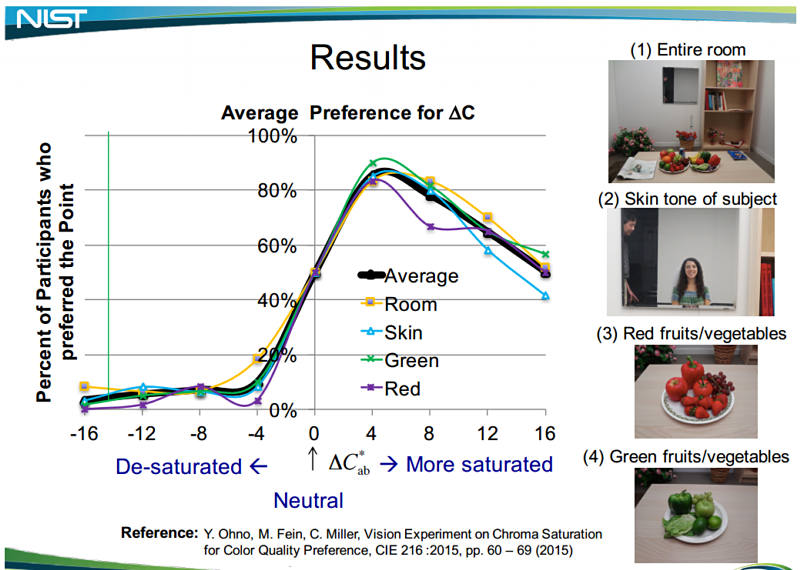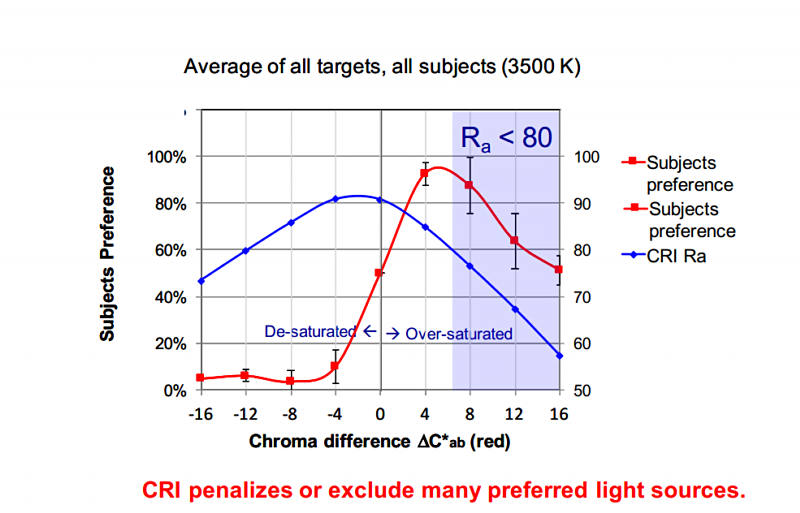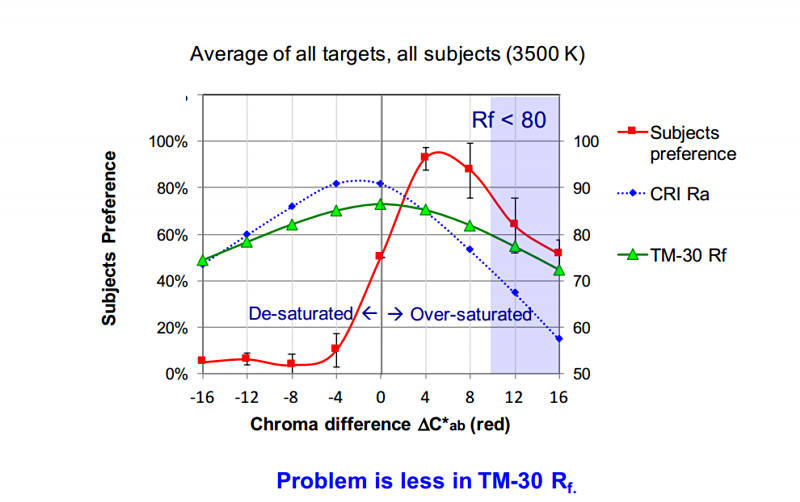
-
This excerpt of data from some vision experiments is valuable, but IMHO has a high risk of being misunderstood.
People like the way how things look to them outdoors, in bright daylight.
Whereever there is less light (like usually indoors), the human eye perceives less color saturation (even if the lighting is of the same spectral distribution / quality as daylight) - simply because the image impression then comes more from the "rods" and less from the "cones" in the retina.
Thus, if you take a picture of something colorful and present it to humans with less light intensity than in bright daylight (which is usually the case with any display or printout), the humans will (on average) prefer a presentation with somewhat elevated saturation levels.
This, however, does not mean that people like "over-saturated" images, they just like images best that appear to them as saturated as they would see them if the object was presented before them in bright daylight.
This is important to consider especially with future HDR displays: If one day such displays become as bright as daylight, a colorful image can be presented on them with the "preferred impression of color" without artificially elevating saturation, just by displaying the image "bright enough".
(And yes, the conventional CRI measure is woefully inadequate to determine light preferred by people, but that is kind of a whole different story...)
-
It is not "some vision experiments" and they had been made inside in specially made place with controlled light source:
A series of vision experiments have been conducted using the NIST Spectrally Tunable Lighting Facility simulating an interior room, where 20 subjects viewed various fruits, vegetables, and their skin tones, under illumination of varied saturation levels at correlated color temperatures (CCT) of 2700 K, 3500 K, and 5000 K.
Whereever there is less light (like usually indoors), the human eye perceives less color saturation (even if the lighting is of the same spectral distribution / quality as daylight) - simply because the image impression then comes more from the "rods" and less from the "cones" in the retina
It is all more complex. Color exist only in your brain and your perception of color can be affected by big amount of things. There is big research area about adaptation and more advanced things.
This, however, does not mean that people like "over-saturated" images, they just like images best that appear to them as saturated as they would see them if the object was presented before them in bright daylight.
Chart shows that people like most slightly oversaturated image, but it also shows that oversaturation is not so bad :-)
-
The part "... conducted using the NIST Spectrally Tunable Lighting Facility simulating an interior room..." exactly supports my point: Had they instead placed their test subjects into an environment lit as bright as usual daylight, the subjects would have opted for "normally" saturated illumination.
I understand that NIST had reason to not do this, as usually images are presented at much lower brightness levels than daylight, so for the purpose of their research, their setting was the more useful. The conclusion that "people like oversaturated images" however needs to be limited to "people like oversaturated images of typical indoor brightness".
-
I understand that NIST had reason to not do this, as usually images are presented at much lower brightness levels than daylight, so for the purpose of their research, their setting was the more useful.
Scientifically this make no sense, as where is no such thing as standard daylight brightness, even daylight spectrum can vary very much (from location, place, atmosphere conditions, time etc).
Thing that you try to explain is that it could be made made outside photopic range by error.
You can check full publication at http://ws680.nist.gov/publication/get_pdf.cfm?pub_id=918717
You can also check who Yoshi Ohno is.
Yet, I'll try to get his comments if I could.
Howdy, Stranger!
It looks like you're new here. If you want to get involved, click one of these buttons!
Categories
- Topics List23,911
- Blog5,718
- General and News1,330
- Hacks and Patches1,148
- ↳ Top Settings33
- ↳ Beginners254
- ↳ Archives402
- ↳ Hacks News and Development56
- Cameras2,342
- ↳ Panasonic984
- ↳ Canon118
- ↳ Sony154
- ↳ Nikon95
- ↳ Pentax and Samsung70
- ↳ Olympus and Fujifilm98
- ↳ Compacts and Camcorders295
- ↳ Smartphones for video96
- ↳ Pro Video Cameras191
- ↳ BlackMagic and other raw cameras116
- Skill1,959
- ↳ Business and distribution66
- ↳ Preparation, scripts and legal38
- ↳ Art149
- ↳ Import, Convert, Exporting291
- ↳ Editors190
- ↳ Effects and stunts115
- ↳ Color grading197
- ↳ Sound and Music280
- ↳ Lighting96
- ↳ Software and storage tips266
- Gear5,407
- ↳ Filters, Adapters, Matte boxes344
- ↳ Lenses1,577
- ↳ Follow focus and gears93
- ↳ Sound496
- ↳ Lighting gear313
- ↳ Camera movement230
- ↳ Gimbals and copters302
- ↳ Rigs and related stuff271
- ↳ Power solutions83
- ↳ Monitors and viewfinders339
- ↳ Tripods and fluid heads139
- ↳ Storage286
- ↳ Computers and studio gear559
- ↳ VR and 3D248
- Showcase1,859
- Marketplace2,834
- Offtopic1,314








